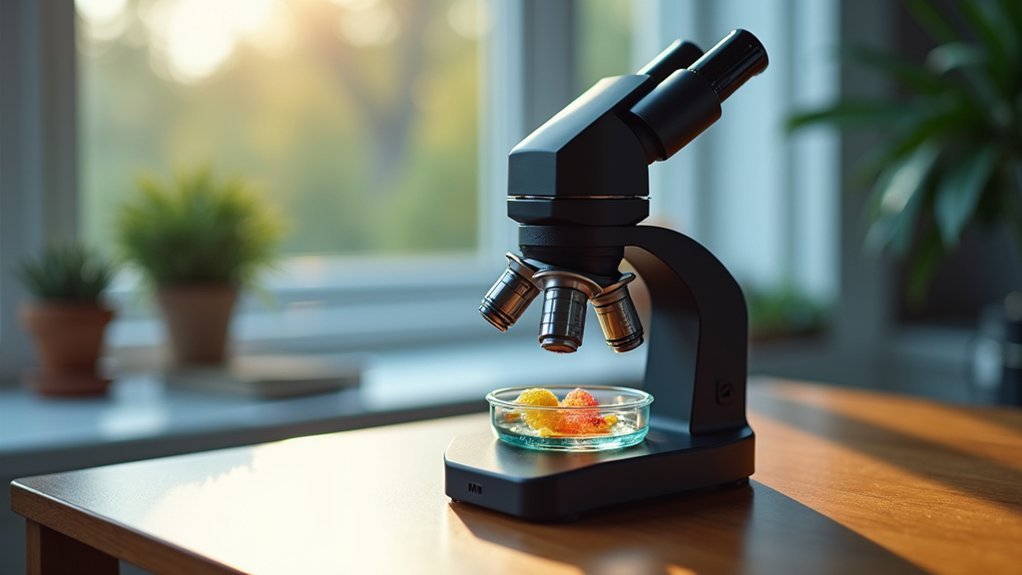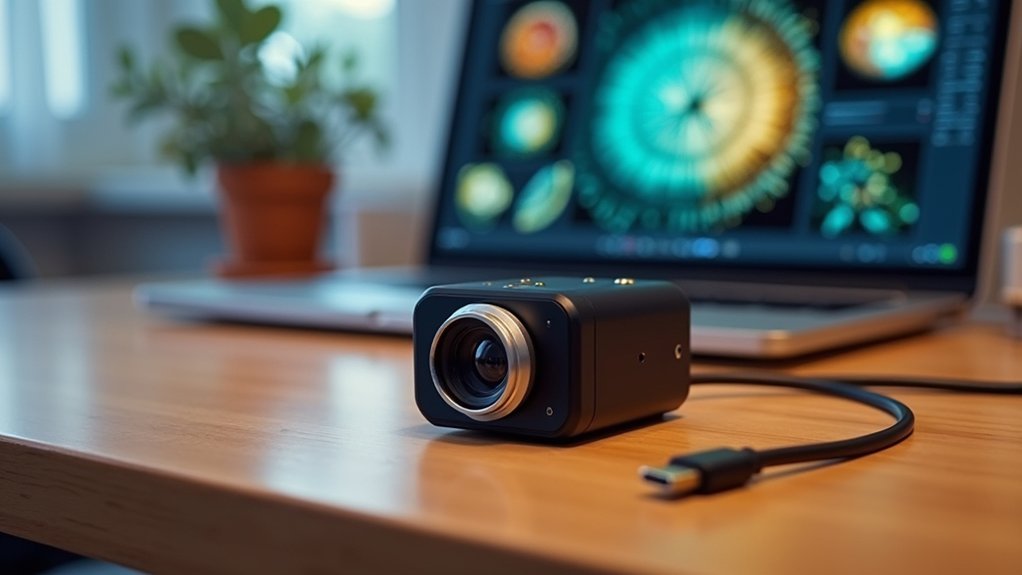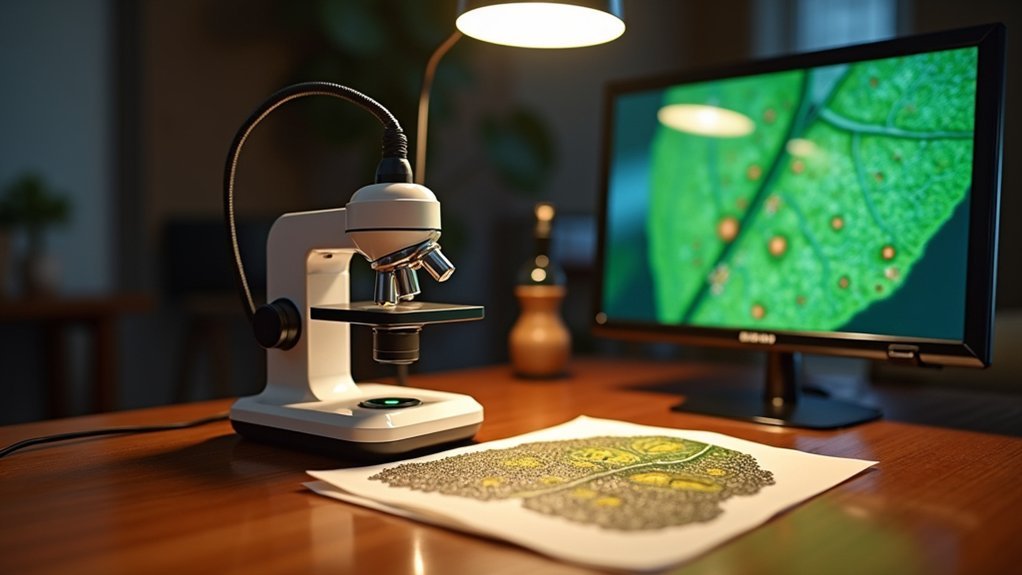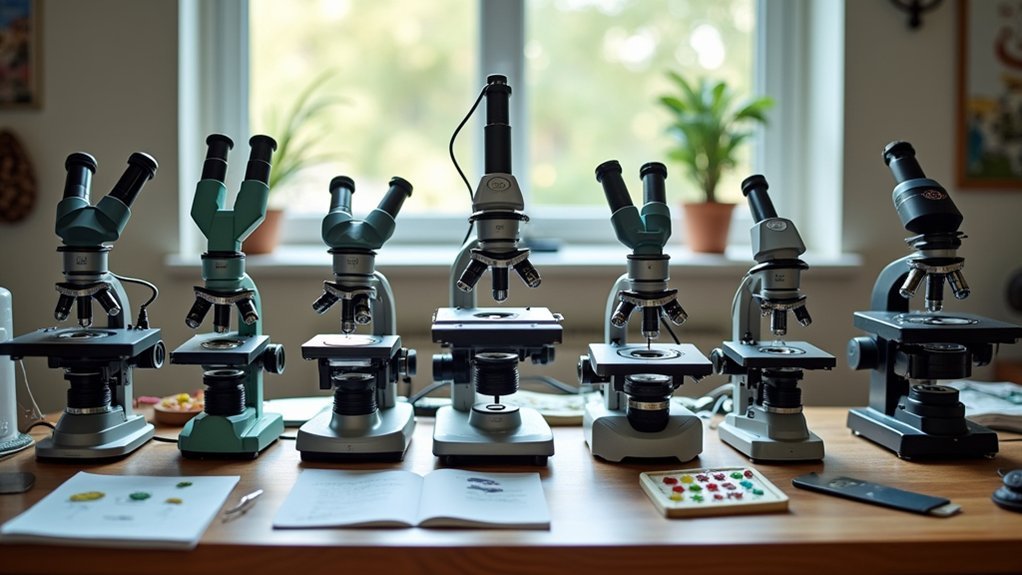Looking for affordable microscope recording options? Consider the AmScope MU Series with 10MP CMOS sensors, OMAX 5MP digital cameras, or standard digital camcorders with closeup lens attachments. SPOT Idea cameras offer economical imaging, while smartphone adapters transform your mobile device into a microscope camera. USB microscopes provide real-time streaming, and HDMI-compatible cameras connect directly to monitors. These budget-friendly solutions range from $50-400, balancing quality and cost for your specific magnification needs.
7 Affordable Microscope Video Recording Solutions

Several budget-friendly options now make microscope video recording accessible to educators, students, and professionals alike. USB-connected cameras like the AmScope MU Series 10.0MP deliver high-resolution imaging and live streaming capabilities without breaking your budget.
The OMAX 5MP Digital Super Speed Camera offers user-friendly software compatible with both Windows and Mac systems, simplifying your digital microscopy workflow. You’ll enjoy smooth video playback with frame rates up to 30 fps, perfect for real-time demonstrations and observations.
Don’t want to replace your entire setup? High-speed digital cameras can attach to existing microscopes via eyepiece adapters. Solutions like SPOT Idea and HDVision cameras provide economical options for capturing quality video, enhancing your visual presentations without requiring extensive technical expertise.
AmScope MU Series CMOS Camera Options
The AmScope MU Series offers you a 10.0MP CMOS camera that connects directly to your computer via USB 2.0, eliminating the need for additional capture devices.
You’ll benefit from the camera’s wide magnification range (40X-2500X) and user-friendly software that supports advanced imaging functions across both Windows and Mac systems.
At a fraction of the cost of industrial microscopy cameras, this C-mount solution provides an accessible entry point for quality microscope video recording in educational and professional settings.
AmScope MU Series CMOS Camera Options
Microscopy enthusiasts seeking affordable video recording solutions will find the AmScope MU Series CMOS cameras particularly significant. The 10.0MP USB 2.0 Color CMOS C-Mount Microscope Camera delivers high-resolution imaging with magnification capabilities from 40X to 2500X.
You’ll appreciate the versatility this camera offers across educational, laboratory, and clinical settings. Its user-friendly software provides advanced features like image stitching, EDF, and video recording capabilities.
The standard C-mount design guarantees compatibility with various microscopes through simple USB connectivity.
While economically priced, be aware of the 3-20 fps frame rate limitations. Users give this camera a 3.8/5 star rating, with mixed feedback regarding software installation and overall experience.
Despite some challenges, it remains a cost-effective option for your microscopy documentation needs.
Affordable Imaging Solutions
Finding affordable imaging solutions for microscopy doesn’t require sacrificing quality when you consider the AmScope MU Series CMOS cameras. This cost-effective digital camera offers impressive 10.0MP resolution while supporting magnifications from 40X to 2500X, making it accessible for students, hobbyists, and professionals alike.
The MU Series provides excellent value with its included reduction lens and adapters that integrate seamlessly with various microscope setups.
Though rated 3.8/5 stars by users who praise its image clarity, be aware of the 3-20 fps frame rate limitations. The user-friendly software enhances your experience with advanced features like image stitching and extended depth of field, all while maintaining compatibility with both Windows and Mac systems.
It’s an economical choice that delivers professional-grade microscopy imaging without breaking your budget.
USB Connectivity Advantages
Seamless integration with your existing microscope setup becomes effortless with the AmScope MU Series CMOS camera’s USB 2.0 connectivity. You’ll enjoy plug-and-play functionality without additional hardware, streamlining your laboratory workflow immediately.
| Feature | Benefit |
|---|---|
| USB 2.0 Connection | Easy setup with standard ports |
| C-Mount Compatibility | Works with various microscopes |
| 10.0MP Resolution | Captures detailed images |
| Live Streaming | Real-time observation capability |
| Included Software | Enables image analysis and stitching |
The camera’s USB connectivity eliminates complex installation procedures, though some users note the software comes on a flash drive rather than CD. This affordable solution delivers professional-quality imaging while supporting advanced functions like video recording—perfect for both educational and professional environments where high-resolution microscopy is essential.
Digital Camcorders With Closeup Lens Attachments
You’ll find several budget-friendly camcorders that work effectively for microscope recording when paired with the right closeup lens attachments.
Canon’s VIXIA series and Sony’s Handycam models offer excellent starting points, with most units priced between $200-400 while delivering HD resolution and HDMI connectivity.
For best results, you can choose between +1, +2, and +4 diopter closeup lenses, with higher numbers providing greater magnification for capturing microscopic details.
SUBHEADING DISCUSSION POINTS
While specialized microscope cameras often command premium prices, digital camcorders with closeup lens attachments present a remarkably affordable alternative for microscopy video recording.
You’ll find these setups particularly useful when working with flat specimens where depth perception issues are minimal.
Digital cameras in the form of camcorders offer significant advantages:
- Cost efficiency – Used camcorders can be purchased at a fraction of dedicated microscope camera prices, making them accessible for hobbyists and educational settings.
- HDMI connectivity – Modern camcorders provide lag-free live feeds directly to monitors or recording devices.
- Adequate magnification – When paired with quality closeup lenses, camcorders capture high-resolution details without requiring extreme magnification.
This approach balances quality and affordability, letting you record professional-looking microscopy videos without specialized equipment investments.
Budget Models Worth Considering
When searching for microscopy recording solutions that won’t break the bank, several digital camcorder models stand out for their exceptional value.
You’ll find these devices offer significant advantages over specialized microscope cameras at a fraction of the cost.
Look for newer consumer camcorders that feature high resolution and faster frame rates for smooth video capture.
The key is selecting models with HDMI ports, ensuring seamless connectivity to your microscope setup.
To maximize your investment, add a closeup lens attachment to your digital camera.
This simple addition dramatically improves detail capture at low magnification levels.
For ideal stability during recording sessions, consider pairing your camcorder with a GRS mount, which will keep your setup level and eliminate unwanted movement that could compromise image quality.
Lens Magnification Options
Closeup lens attachments transform standard digital camcorders into powerful microscopy tools, expanding their capabilities far beyond consumer video recording.
By adding these specialized lenses to your camera, you’ll reduce the minimum focusing distance, allowing you to capture detailed specimen images at various magnification levels.
With the right closeup lens configuration, you can achieve:
- Low-power magnification (40X-100X) – perfect for observing larger specimens and cellular structures
- Medium-power magnification (100X-400X) – ideal for detailed tissue examination
- High-power magnification (up to 2500X) – suitable for cellular and subcellular observations
You’ll find this approach particularly cost-effective compared to dedicated microscope cameras.
For best results, make sure your camera mount remains stable and level during recording sessions to maintain image clarity and prevent distortion.
SPOT Idea CMOS Cameras for Economical Imaging
For researchers and hobbyists seeking quality microscope imaging without excessive costs, SPOT Idea CMOS cameras represent an excellent balance between performance and affordability.
These cameras deliver high-quality color video capture specifically designed for microscopy applications, making them accessible for students and enthusiasts alike.
You’ll appreciate the cross-platform compatibility with both Windows® and Macintosh® systems, allowing seamless integration with your existing setup.
The user-friendly software includes extensive tools for image capture, analysis, and reporting—enhancing your microscopy workflow.
Despite their economical price point, SPOT Idea cameras produce images suitable for journal publication and industrial documentation.
Your investment is protected by a 2-year manufacturer’s warranty, providing peace of mind as you explore the world of affordable microscopic imaging.
HDMI-Compatible Microscope Cameras Under $200

The microscopy landscape has changed dramatically with the introduction of affordable HDMI-compatible cameras priced under $200.
You’ll find options like the AmScope MU Series 10.0MP camera that offer high-resolution imaging and live streaming capabilities suitable for both educational and professional environments.
These HDMI-compatible microscope cameras typically connect via USB, making them versatile additions to your laboratory setup.
When selecting your camera, consider:
- Frame rates between 3-20 fps – sufficient for basic recording but evaluate your specific needs
- Software functionality – look for image stitching and video recording features
- System compatibility – check if the camera works with your computer’s operating system
While most budget cameras deliver decent image clarity and color fidelity, be mindful of potential software installation challenges that vary between models and computer systems.
Smartphone Adapters for Microscope Video Recording
Beyond dedicated HDMI cameras, smartphone adapters represent an even more economical approach to microscope video recording. These lightweight devices securely attach your mobile phone to the microscope’s eyepiece, transforming your everyday device into a powerful documentation tool.
You’ll find most smartphone adapters feature adjustable clamps that accommodate various eyepiece diameters, making them compatible with virtually any microscope model. Built-in stabilization features minimize vibrations during recording, ensuring your images and videos remain crisp and professional.
What makes these adapters particularly valuable is their portability. You can easily conduct fieldwork without lugging heavy equipment.
Plus, you’ll enjoy the immediate ability to share your findings via social media or messaging apps—perfect for collaborative learning environments where real-time feedback enhances the educational experience.
USB Microscope Cameras With Real-Time Streaming

Three key advantages make USB microscope cameras an excellent middle-ground solution for researchers and educators seeking affordable recording options.
These devices offer high-resolution image capture up to 10.0MP while delivering smooth 25-30 fps video performance for your real-time streaming needs.
With their plug-and-play USB connectivity, you’ll easily connect to both Windows and Mac systems for immediate use.
The included software enhances your experience with advanced capabilities you’ll appreciate.
Robust imaging software puts powerful analysis tools and enhancement options right at your fingertips.
- Standard C-mount design guarantees compatibility with most microscope models
- User-friendly software supports video recording, image stitching, and analysis features
- Live streaming capabilities allow immediate sharing of microscopic observations for collaborative research or teaching
You’ll find these cameras strike the perfect balance between professional functionality and reasonable cost.
Frequently Asked Questions
Can Microscopes Record Video?
Yes, many microscopes can record video. You’ll find that digital models come with built-in cameras, or you can attach external cameras to traditional microscopes for high-resolution video capture and live streaming.
Which Microscope Is Inexpensive and Allows People to See Microscopic Cells?
You’ll find the AmScope MU Series 10.0MP USB Camera is an inexpensive option for viewing microscopic cells. It offers 40X-2500X magnification, high-resolution imaging, and comes with user-friendly software for detailed cellular observation.
What Is the Price of Portable LCD Digital Microscope?
You’ll find portable LCD digital microscopes priced between $50-$300. Entry-level models cost less but offer fewer megapixels, while premium options with higher resolution and better features sit at the upper end of this range.
How Do You Set up a Microscope Video?
You’ll need to attach a compatible camera to your microscope using an adapter, connect it to a display device, adjust focus and lighting, then use recording software to capture your specimen video.
In Summary
You’ve now discovered seven budget-friendly ways to capture microscopic worlds on video. Whether you’re using AmScope cameras, adapting digital camcorders, trying SPOT Idea systems, exploring HDMI options under $200, attaching your smartphone, or streaming with USB cameras, you don’t need expensive equipment to document your microscopic findings. Choose the solution that fits your specific needs and budget, and you’ll be recording detailed microscopic footage in no time.





Leave a Reply